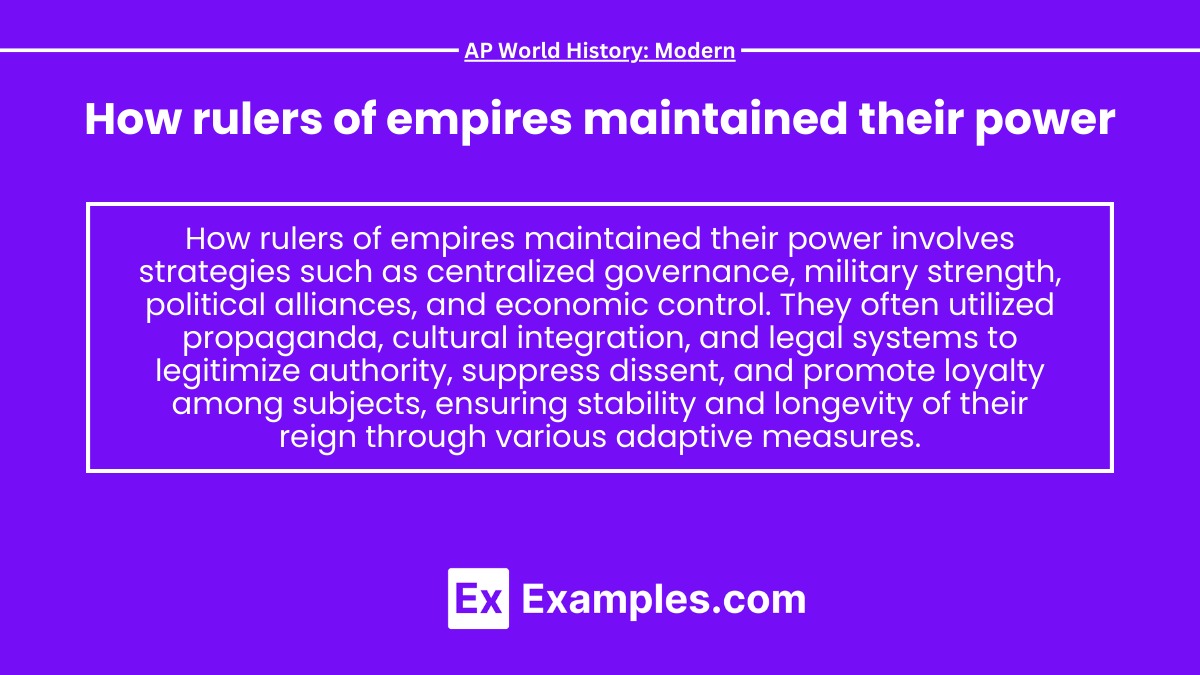Rulers of empires maintained their power through centralized authority, military strength, religious and ideological control, economic management, and infrastructure development. They used bureaucratic systems, controlled trade routes, and imposed taxes to sustain their empires. Propaganda, cultural integration, and legal codification further reinforced their dominance, ensuring loyalty and unity, while co-opting local elites prevented the rise of rival power centers.
Learning Objective
In studying “How Rulers of Empires Maintained Their Power” for AP World History: Modern, you should learn to identify the strategies used by rulers to consolidate authority, including military force, administrative structures, and legal systems. Analyze how rulers employed religion, culture, and ideology to legitimize their rule, and evaluate the role of economic policies, taxation, and control over trade in maintaining stability. Additionally, explore the use of propaganda, diplomacy, and alliances to manage internal dissent and external threats, and examine the long-term effectiveness of these methods in sustaining imperial power.
1. Centralized Authority and Bureaucratic Systems
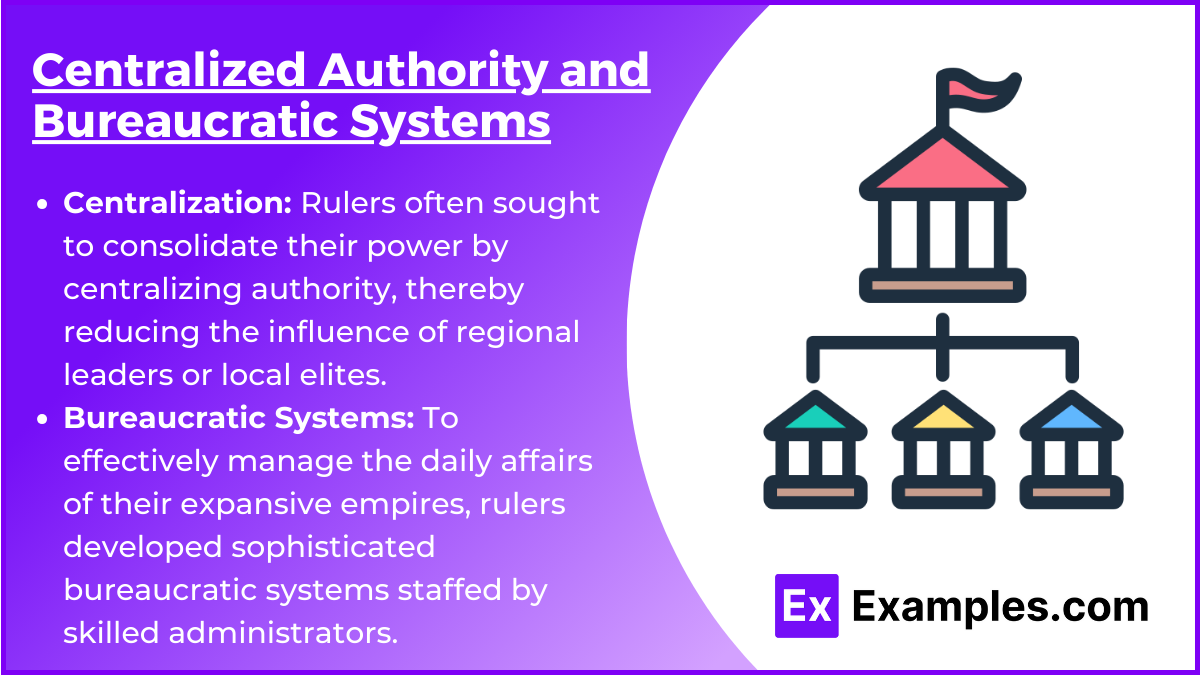
- Centralization: Rulers often sought to consolidate their power by centralizing authority, thereby reducing the influence of regional leaders or local elites. This centralization meant that all major decisions, laws, and policies originated from a single, authoritative source, typically the monarch or emperor. By doing so, rulers ensured a more unified and consistent administration across their territories, preventing fragmentation and maintaining tighter control over vast expanses.
- Bureaucratic Systems: To effectively manage the daily affairs of their expansive empires, rulers developed sophisticated bureaucratic systems staffed by skilled administrators. These bureaucracies were responsible for tasks such as tax collection, law enforcement, record-keeping, and the implementation of imperial policies. Bureaucrats often underwent rigorous training and were selected based on merit or loyalty to the ruler, ensuring an efficient and reliable administrative system.
- Example: The Ottoman Empire’s “Devshirme” system serves as a prime example of centralized authority in action. Christian boys from conquered territories were recruited, converted to Islam, and trained as administrators or soldiers. This practice not only ensured a steady supply of capable officials but also guaranteed their loyalty to the Sultan, as they were removed from their original cultural and familial ties.
2. Military Strength and Control
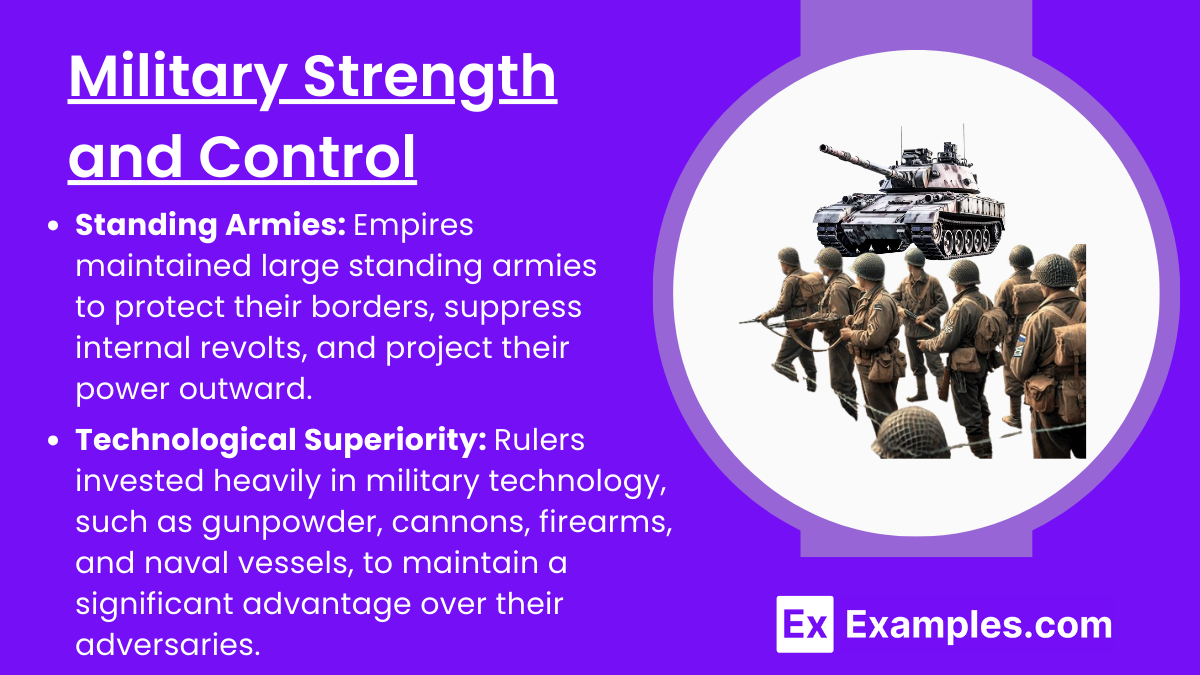
- Standing Armies: Empires maintained large standing armies to protect their borders, suppress internal revolts, and project their power outward. These armies were often well-trained, disciplined, and equipped, serving as a deterrent against potential threats and ensuring the ruler’s ability to swiftly respond to uprisings or invasions.
- Technological Superiority: Rulers invested heavily in military technology, such as gunpowder, cannons, firearms, and naval vessels, to maintain a significant advantage over their adversaries. This technological edge allowed empires to conquer new territories, defend their lands, and maintain internal order with greater efficiency.
- Example: The Mughal Empire, especially under rulers like Akbar, developed a formidable military with a strong cavalry and advanced artillery. This military strength not only enabled them to expand their empire through successful conquests but also ensured that they could defend their territories against external threats.
3. Use of Religion and Ideology
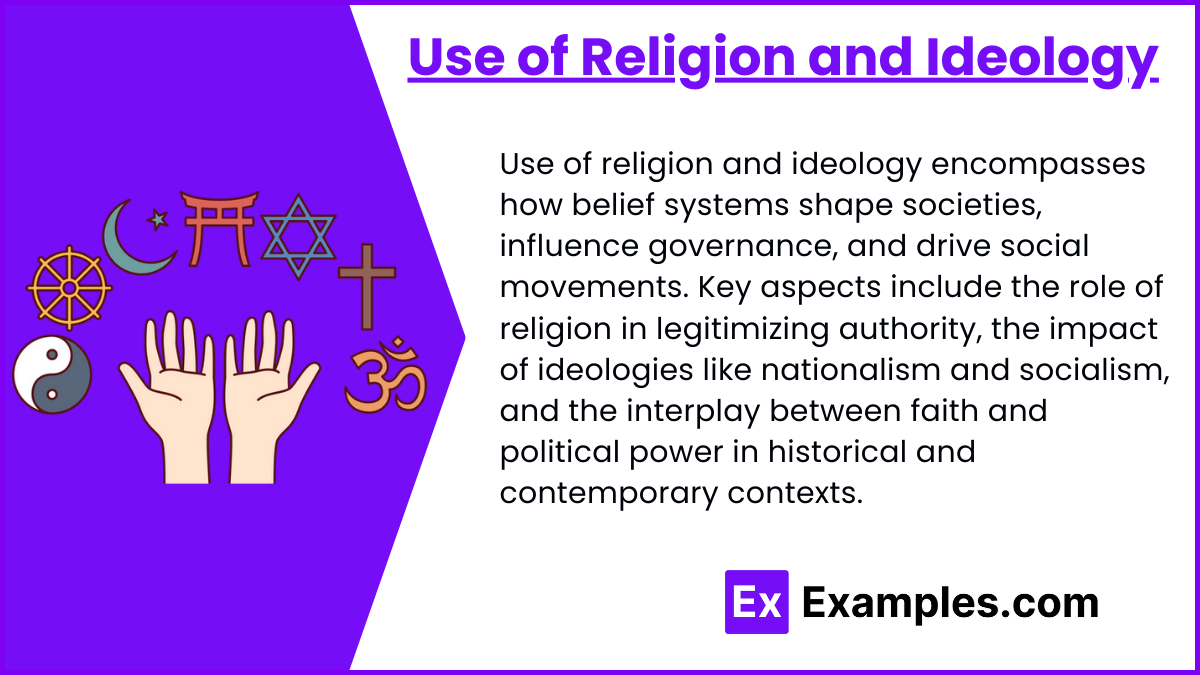
Use of religion and ideology encompasses how belief systems shape societies, influence governance, and drive social movements. Key aspects include the role of religion in legitimizing authority, the impact of ideologies like nationalism and socialism, and the interplay between faith and political power in historical and contemporary contexts.
- Legitimizing Rule: Many rulers claimed divine authority or religious justification for their reign, framing their rule as ordained by a higher power. This tactic made their leadership appear unchallengeable, as opposing the ruler could be seen as defying divine will, thereby discouraging rebellion and fostering loyalty among their subjects.
- Religious Tolerance or Conversion: To maintain control over diverse populations, some empires practiced religious tolerance, allowing different faiths to coexist peacefully within their borders. This strategy helped reduce internal conflicts and won the loyalty of various ethnic and religious groups. In contrast, other empires enforced conversion to a state religion, creating a unified religious identity that strengthened their rule.
- Example: The Qing Dynasty used Confucian ideals to justify their authority, aligning themselves with traditional Chinese philosophies. On the other hand, the Safavid Empire promoted Shia Islam to distinguish themselves from neighboring Sunni powers, reinforcing loyalty among their predominantly Shia population.
4. Economic Control and Trade
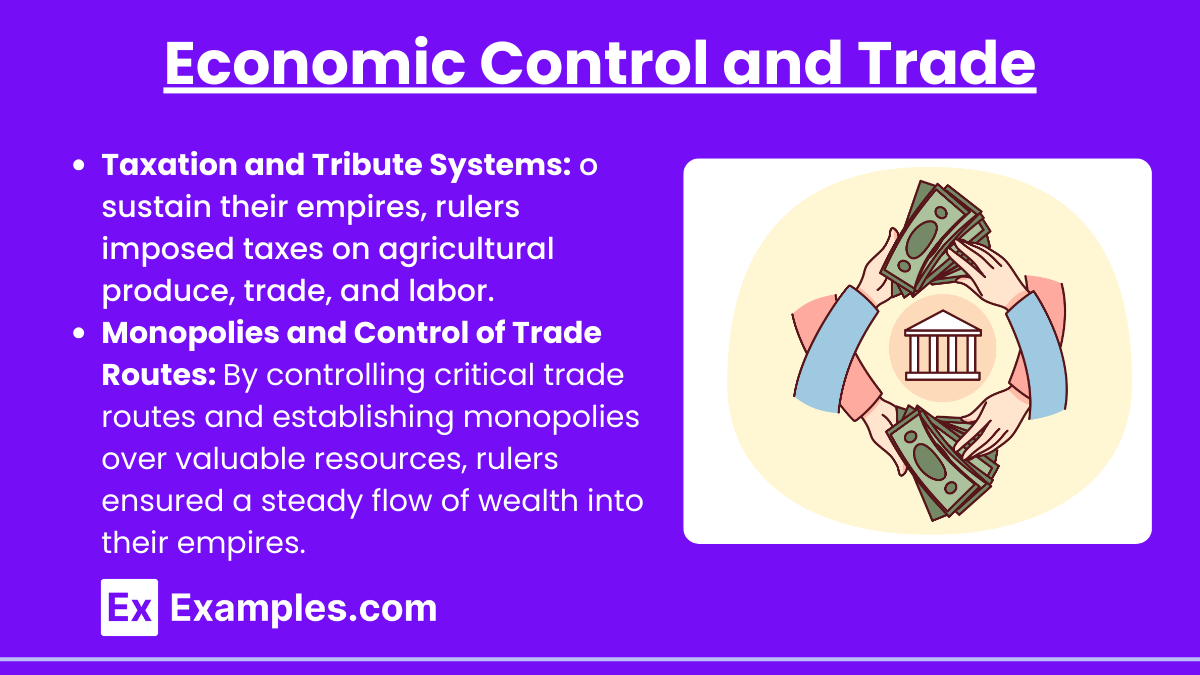
- Taxation and Tribute Systems: To sustain their empires, rulers imposed taxes on agricultural produce, trade, and labor. These taxes provided the revenue needed for military campaigns, public works, and the maintenance of bureaucratic systems. In addition, some empires demanded tribute from conquered territories, further enhancing their wealth and power.
- Monopolies and Control of Trade Routes: By controlling critical trade routes and establishing monopolies over valuable resources, rulers ensured a steady flow of wealth into their empires. This economic control not only enriched the state but also allowed rulers to finance wars, build infrastructure, and maintain the loyalty of their subjects through patronage.
- Example: The Spanish Empire’s control over the silver mines of Potosí in present-day Bolivia was a key factor in its economic dominance. The immense wealth generated from these mines funded military campaigns, built impressive infrastructure, and allowed Spain to exert influence over European politics.
5. Infrastructure and Communication Networks

- Transportation Systems: Roads, bridges, railways, and airports that enable the movement of goods and people.
- Utilities: Essential services such as electricity, water supply, sewage, and waste management systems.
- Telecommunication Networks: Systems for transmitting data over distances, including fiber optics, satellite communication, and wireless networks.
Examples
Example 1: Ottoman Empire (Devshirme System)
The Ottomans recruited Christian boys, converting and training them as loyal soldiers or administrators, ensuring a steady supply of capable, loyal officials directly serving the Sultan.
Example 2: Mughal Empire (Military Strength)
The Mughals, under Akbar, maintained a powerful, well-trained army with advanced artillery and cavalry, which helped expand and protect the empire, deterring rebellions and external threats.
Example 3: Spanish Empire (Control of Trade and Wealth)
Spain controlled silver mines in Potosí, generating immense wealth. This economic power funded military campaigns, infrastructure, and political influence, maintaining dominance over vast territories.
Example 4: Qing Dynasty (Confucian Ideals)
The Qing rulers adopted Confucian principles, aligning with traditional Chinese values. This helped legitimize their rule, gain loyalty, and integrate diverse ethnic groups under a unified ideology.
Example 5: Inca Empire (Road Network)
The Incas built an extensive road network, facilitating communication, trade, and military movement. This infrastructure ensured efficient administration and quick response to rebellions, maintaining centralized control.
MCQs
Question 1
How did the Ottoman Empire maintain a steady supply of loyal administrators and soldiers?
A) Promoting local elites to positions of power
B) Establishing trade monopolies across their empire
C) Using the Devshirme system to recruit and train Christian boys
D) Building extensive roads to control communication
Answer: C) Using the Devshirme system to recruit and train Christian boys
Explanation: The Devshirme system was a unique method employed by the Ottomans, where Christian boys were taken from their families, converted to Islam, and trained as soldiers or bureaucrats loyal to the Sultan. This ensured the ruler had a continuous supply of capable, loyal officials while minimizing the risk of rebellion from these newly integrated individuals.
Question 2
Which of the following strategies did the Mughal Empire use to maintain power?
A) Relying exclusively on alliances with European powers
B) Developing a strong military force with advanced artillery
C) Implementing Shia Islam as the state religion
D) Expanding solely through peaceful treaties with neighboring states
Answer: B) Developing a strong military force with advanced artillery
Explanation: The Mughal Empire, especially under rulers like Akbar, maintained a powerful standing army equipped with advanced artillery and cavalry units. This military strength enabled them to protect the empire’s borders, expand their territory, and suppress internal revolts, which were key to maintaining long-term control over their vast domains.
Question 3
How did the Spanish Empire leverage its economic power to maintain dominance?
A) By enforcing religious tolerance across the empire
B) Through control of silver mines, especially in Potosí
C) By eliminating all local leaders and replacing them with Spanish officials
D) By establishing a large network of alliances with Native American tribes
Answer: B) Through control of silver mines, especially in Potosí
Explanation: The Spanish Empire’s control of the silver mines in Potosí generated immense wealth, which funded military campaigns and political dominance. This economic control enabled Spain to maintain a strong, centralized government, suppress rebellions, and influence European politics, reinforcing their dominance over vast overseas territories.

